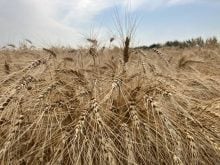WINNIPEG/OTTAWA, Dec 6 (Reuters) – Canada’s wheat and canola crops withstood unfavorable autumn weather, topping Statistics Canada’s previous estimates and last year’s production, according to the government agency’s report on Tuesday.
Canola production was 18.4 million tonnes, up 0.3 percent from last year and the second-largest Canadian canola crop on record, but short of the average trade guess of 18.8 million tonnes.
Statscan pegged the all-wheat crop at 31.7 million tonnes, up 15 percent from last year and exceeding the average trade expectation of 30.7 million tonnes.
The wheat harvest was the second-biggest in 25 years.
Read Also

U.S. grains: Soybean futures hit one-month high on U.S.-China trade hopes
Chicago Board of Trade soybean futures hit their highest level in a month on Monday on renewed optimism over U.S.-China trade talks after U.S. President Donald Trump said he believed Beijing would agree to a soybean trade deal and will buy U.S. soy again.
The report has had little effect on futures markets this morning. Crop prices are generally up at 10 a.m. CST.
January canola is trading at $531.30, up $4. Minneapolis March spring wheat is tradeing at US$5.37 ½, up 2 ¾ cents
The Statcan estimates were met with greater skepticism than usual from traders and analysts, as Statscan surveyed farmers during unusually snowy, then mild, autumn weather that raised fears that growers would be unable to finish harvesting before winter.
“The weather during the time the survey was taken would have left a whole lot of uncertainty,” said Dave Reimann, grain market analyst at Cargill Ltd.
“I’m not sure how farmers could answer those questions with a lot of confidence.”
The all-wheat category includes spring and winter wheat, as well as durum. Statscan estimated record-large durum production at 7.8 million tonnes, up 44 percent from a year ago and topping the average trade expectation of 7.2 million.
Higher-than-expected Canadian wheat production is not a market “game-changer,” Reimann said.
But it adds to record global production, according to the International Grains Council.
Estimates for wheat and canola crops came in higher than Statscan’s previous estimates in August.
Snow blanketed crops in Alberta and Saskatchewan in October, stopping farmers for weeks from finishing the harvest. An unusual November warm spell allowed them a last chance to bring in most of the remaining crop.
Estimates of Production of principal field crops
In 1,000 tonnes
|
2014 |
2015 |
2016 |
15 to 16 % change |
|
| Total wheat |
29,420 |
27,594 |
31,729 |
15.0 |
|
• Durum |
5,193 |
5,389 |
7,762 |
44.0 |
|
•Spring |
21,298 |
19,962 |
20,454 |
2.5 |
|
•Winter |
2,929 |
2,243 |
3,513 |
56.6 |
| Barley |
7,119 |
8,226 |
8,784 |
6.8 |
| Canary |
125 |
149 |
120 |
-19.4 |
| Canola |
16,410 |
18,377 |
18,424 |
0.3 |
| Chick peas |
123 |
84 |
75 |
-9.9 |
| Corn |
11,487 |
13,559 |
13,193 |
-2.7 |
| Dry beans |
273 |
243 |
229 |
-5.9 |
| Dry peas |
3,810 |
3,201 |
4,836 |
51.1 |
| Fall Rye |
218 |
226 |
409 |
81.2 |
| Flax |
873 |
942 |
579 |
-38.5 |
| Lentils |
1,987 |
2,541 |
3,248 |
27.9 |
| Mustard |
198 |
123 |
234 |
89.5 |
| Oats |
2,979 |
3,428 |
3,147 |
-8.2 |
| Soybeans |
6,049 |
6,371 |
6,463 |
1.4 |
| Sunflower |
55 |
73 |
51 |
-30.3 |














